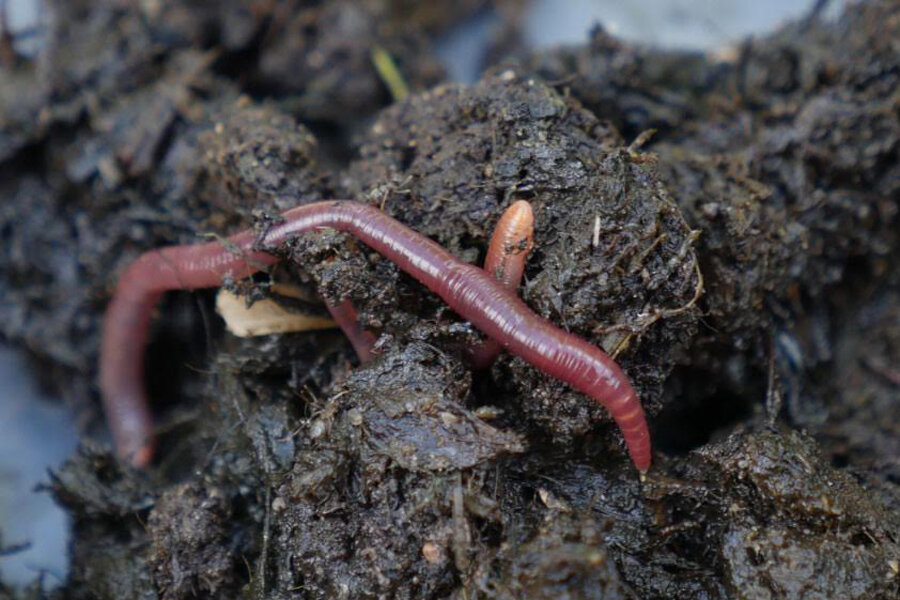Scientists explain earthworms' leaf-busting guts
Earthworms are known for their indiscriminate digestive tracts, so perhaps it comes as no surprise that they can digest some plant toxins without difficulty.
Researchers have identified unique chemical compounds in the digestive tracts of 14 earthworm species. These compounds counteract the defensive toxins produced by plants, allowing earthworms to consume them safely. A new study, led by Imperial College metabolomics expert Jake Bundy, appeared Tuesday in Nature Communications.
“Earthworms are so easy to find and study, yet there are still new and surprising things to discover,” Dr. Bundy says. “It makes me wonder how many other unique biochemical mechanisms there are out there that we don't know about, just because we haven't looked.”
As sedentary organisms, plants rely on creative measures to deter hungry herbivores. Many plants produce defensive chemicals called polyphenols. By binding gut enzymes, polyphenols inhibit the digestion of plant matter. Dead plants retain these chemicals even as they fall to the soil, discouraging would-be decomposers in the process.
“Plant defense chemicals definitely have a negative effect,” Bundy says. “Humans and other vertebrates have evolved their own, separate way of dealing with plant polyphenols: we produce specialized chemicals in our saliva that bind to the polyphenols so tightly that they then pass through our gut without interacting.”
Earthworms have evolved a different solution altogether. Their guts produce drilodefensins, which disrupt the chemical properties of polyphenols. These compounds are classified as surfactants, which act a lot like detergents – a large amount of purified drilodefensins could clean your dishes.
In fact, Bundy and colleagues found that commercial detergent also protected against polyphenols. But you can't simply swap out an earthworm's drilodefensins with Tide and expect the worm to thrive, because it would inhibit other enzyme activity. Bundy suggests that earthworm enzymes and drilodefensins evolved in tandem to be compatible.
With three types of imaging mass spectrometry (IMS), Bundy and colleagues were able to observe cross-sections of their worms at an extremely fine scale. IMS works like a “biochemical microscope,” able to provide targeted pictures of objects smaller than a single cell.
“We had really clear images of drilodefensins found in the earthworm gut, and only in the gut,” Bundy says. “In this particular case, the IMS was essential – traditional methods of testing involve dissecting out the gut and then scooping or squeezing out the contents, but this didn't work in earthworms. The drilodefensins turn out to be very easily degraded, so they just disappear if you carry out a dissection.”
Now that they have been identified, these compounds could have environmental and commercial uses, Bundy says.
“Biosurfactants do have very useful applications – for instance, in helping clear up oil spills by stimulating bioremediation,” Bundy says. “It's too early to say yet what the specific applications of earthworm compounds could be, but I definitely think they could have a valuable commercial use.”
“It's also possible that earthworm enzymes, which degrade the natural earthworm metabolites, could also be used to help clean up wastewater and get rid of synthetic detergents before they enter the environment – although I do emphasize that this is still hypothetical.”
For better or for worse, earthworms have a profound effect on their environments. In many North American forests, invasive earthworms are consuming huge mounds of accumulated leaf litter. In doing so, they can inhibit the growth of endemic species and significantly alter local ecosystems. But at the same time, earthworms are key players in terrestrial carbon cycles.
“Earthworms play the largest role in carbon turnover of macroinvertebrates in many soils,” Bundy says. “This sounds a bit dry, but putting it another way, they do have a key role in carbon turnover in soils at a global level. They are often referred to as ‘ecosystem engineers’ for their ability to affect the landscapes they are found in.”






